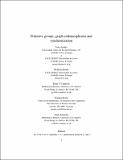Files in this item
Primitive groups, graph endomorphisms and synchronization
Item metadata
| dc.contributor.author | Araújo, João | |
| dc.contributor.author | Bentz, Wolfram | |
| dc.contributor.author | Cameron, Peter Jephson | |
| dc.contributor.author | Royle, Gordon | |
| dc.contributor.author | Schaefer, Artur | |
| dc.date.accessioned | 2016-10-12T08:30:12Z | |
| dc.date.available | 2016-10-12T08:30:12Z | |
| dc.date.issued | 2016-12 | |
| dc.identifier | 244980137 | |
| dc.identifier | 26975ef2-400c-4d02-9d56-8b6f557083c2 | |
| dc.identifier | 85014132203 | |
| dc.identifier | 000393186800003 | |
| dc.identifier.citation | Araújo , J , Bentz , W , Cameron , P J , Royle , G & Schaefer , A 2016 , ' Primitive groups, graph endomorphisms and synchronization ' , Proceedings of the London Mathematical Society , vol. 113 , no. 6 , pp. 829-867 . https://doi.org/10.1112/plms/pdw040 | en |
| dc.identifier.issn | 0024-6115 | |
| dc.identifier.other | ORCID: /0000-0003-3130-9505/work/58055675 | |
| dc.identifier.uri | https://hdl.handle.net/10023/9648 | |
| dc.description | The third author has been partially supported by the Fundação para a Ciência e a Tecnologia through the project CEMAT-CIÊNCIAS UID/Multi/04621/2013. | en |
| dc.description.abstract | Let Ω be a set of cardinality n, G be a permutation group on Ω and f:Ω→Ω be a map that is not a permutation. We say that G synchronizes f if the transformation semigroup ⟨G,f⟩ contains a constant map, and that G is a synchronizing group if G synchronizes every non-permutation. A synchronizing group is necessarily primitive, but there are primitive groups that are not synchronizing. Every non-synchronizing primitive group fails to synchronize at least one uniform transformation (that is, transformation whose kernel has parts of equal size), and it had previously been conjectured that this was essentially the only way in which a primitive group could fail to be synchronizing, in other words, that a primitive group synchronizes every non-uniform transformation. The first goal of this paper is to prove that this conjecture is false, by exhibiting primitive groups that fail to synchronize specific non-uniform transformations of ranks 5 and 6. As it has previously been shown that primitive groups synchronize every non-uniform transformation of rank at most 4, these examples are of the lowest possible rank. In addition, we produce graphs with primitive automorphism groups that have approximately √n non-synchronizing ranks, thus refuting another conjecture on the number of non-synchronizing ranks of a primitive group. The second goal of this paper is to extend the spectrum of ranks for which it is known that primitive groups synchronize every non-uniform transformation of that rank. It has previously been shown that a primitive group of degree n synchronizes every non-uniform transformation of rank n−1 and n−2, and here this is extended to n−3 and n−4. In the process, we will obtain a purely graph-theoretical result showing that, with limited exceptions, in a vertex-primitive graph the union of neighbourhoods of a set of vertices A is bounded below by a function that is asymptotically √|A|. Determining the exact spectrum of ranks for which there exist non-uniform transformations not synchronized by some primitive group is just one of several natural, but possibly difficult, problems on automata, primitive groups, graphs and computational algebra arising from this work; these are outlined in the final section. | |
| dc.format.extent | 39 | |
| dc.format.extent | 387180 | |
| dc.language.iso | eng | |
| dc.relation.ispartof | Proceedings of the London Mathematical Society | en |
| dc.subject | Permutation group | en |
| dc.subject | Semigroup | en |
| dc.subject | Synchronization | en |
| dc.subject | Graph endomorphism | en |
| dc.subject | QA Mathematics | en |
| dc.subject | Mathematics(all) | en |
| dc.subject | T-NDAS | en |
| dc.subject | BDC | en |
| dc.subject | R2C | en |
| dc.subject.lcc | QA | en |
| dc.title | Primitive groups, graph endomorphisms and synchronization | en |
| dc.type | Journal article | en |
| dc.contributor.institution | University of St Andrews. Pure Mathematics | en |
| dc.contributor.institution | University of St Andrews. Centre for Interdisciplinary Research in Computational Algebra | en |
| dc.identifier.doi | https://doi.org/10.1112/plms/pdw040 | |
| dc.description.status | Peer reviewed | en |
This item appears in the following Collection(s)
Items in the St Andrews Research Repository are protected by copyright, with all rights reserved, unless otherwise indicated.

